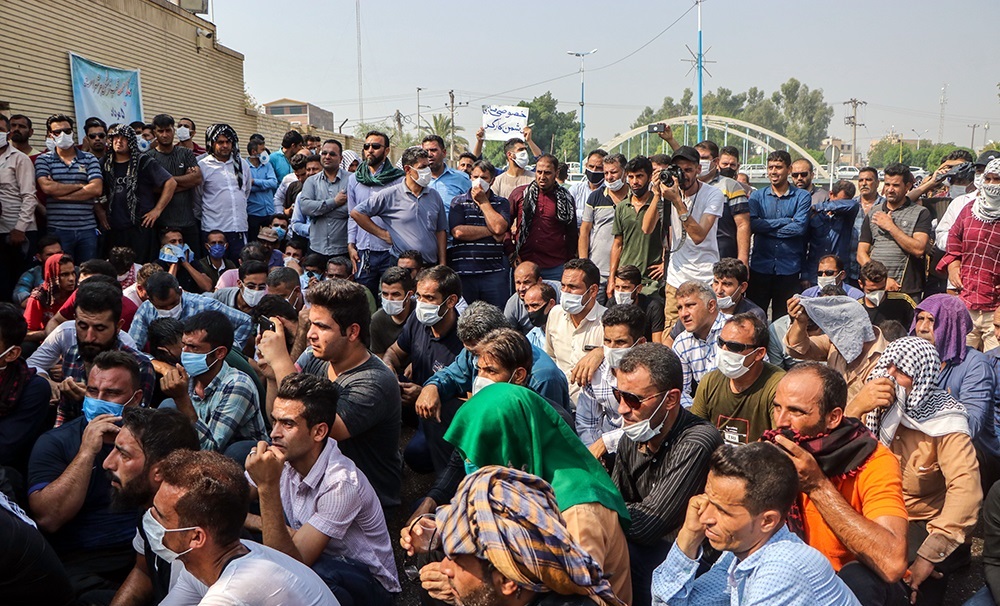In the last month there have been over 150 strikes and protests across Iran. This is only the latest strike wave since 2018. The ongoing struggles include oil workers in Khuzestan, the Haft Tappeh sugar plantation workers, miners in Azerbaijan, Khorasan and Kerman, national protests of teachers, and ongoing farmers’ protests among others. All the while, the social crisis in Iran is continuing to plummet to new depths.
Militant Khuzestan: oil workers and Haft Tappeh workers strike
The class struggle has been most militant in the province of Khuzestan with the ongoing struggle of Haft Tappeh workers and the strike of oil workers. The workers of the Haft Tappeh sugar cane plantation have been fighting for the expropriation of the company and the arrest of their former employer for years. Their persistent struggle, organised by the Haft Tappeh union through a workers’ council, has forced the regime to carry out its verdict, and from January this year, the corrupt former employer was imprisoned. Nonetheless, the fate of the plantation has remained uncertain, with rumors of its re-privatisation continuing to circulate. The Haft Tappeh workers’ union is demanding renationalisation under workers’ control.
Meanwhile, oil and gas workers persist in their struggle and have been on strike since late June, although the struggle has increasingly become isolated to Khuzestan province, involving workers in Mahshahr, Ahvaz and Assaluyeh. This strike was inspired by the methods of the Haft Tappeh workers, with the workers’ strike-organising council calling for the forming of strike committees in every workplace in order to combat the influence of the regime-led labour organisations.
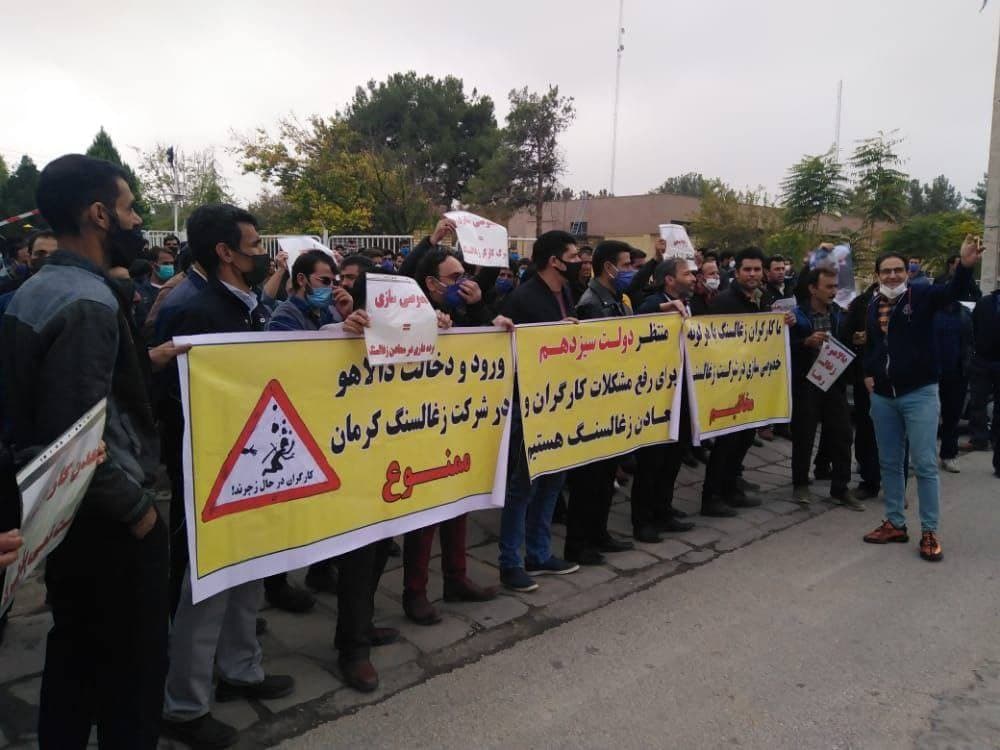 Coal miners in Sarakhs, Khorasan Razavi province have been on strike since 27 September / Image: Iranworkers, Twitter
Coal miners in Sarakhs, Khorasan Razavi province have been on strike since 27 September / Image: Iranworkers, Twitter
Despite the militancy of the national strike, which is an important step forward from the local, disconnected strikes that preceded it, the decentralisation of the independent strike committee allowed the regime to sow confusion among the ranks of the strikers. The Raisi government and private contractors have made empty promises in order to split workers from the national strike led by the workers’ strike organising council. But already, a few workplaces that abandoned the campaign have begun realising that the regime has nothing to offer them, and they have launched renewed protests for their demands.
One oil worker from Assaluyeh explained the way forward in an open letter: “I call on all my colleagues to work centrally with the organising council. By doing so, we will both strengthen our line of struggle and give a stronger answer to some unbelievers”. The striking and protesting oil workers must unite and campaign for a decisive strike within the oil sector and reach out to striking and protesting workers in their areas.
Miners’ strikes from Kerman to Azerbaijan to Khorasan
Coal miners in Sarakhs, Khorasan Razavi province have been on strike since 27 September. Inspired by the oil workers and Haft Tappeh sugar cane workers, the coal miners organised a strike committee, setting forth demands for: full-time contracts, equalisation of wages and benefits between directly employed and temporarily contracted workers, a minimum wage at 10 million toman, the immediate renewal of insurance, payment of unpaid wages, and the complete renationalisation of the mines. Miners, much like the rest of the working class, have engaged in continuous strikes and protests against starvation wages of between 5 to 7 million toman. As with the rest of the working class, the majority of miners work under temporary three months contracts. On the failure to pay even these meagre wages on such insecure contracts, one participant in the strike explained: “we, the workers of the Sarakhs coal mine, have not received a salary for 15 months. They give us no choice”.
These demands rapidly spread to other mines including, among others, the Zarand coal mines in Kerman province and Sungun mine, in Azerbaijan province – the largest copper mine in Iran. In Sangun the strike was temporarily stopped on 5 October following promises from the regime, only to recommence on 12 October. On October 13, the regime deployed a counter-insurgency unit against the Zarand coal miners; wary that the militant demand for renationalisation would spread to other privatised coal mines in the area. The regime viciously attacked a rally of strikers and their families, bringing an end to the strike. Meanwhile the directly employed workers at the Kerman Coal Company have been on strike since 9 November under the leadership of the Islamic workers’ councils.
The call for the formation of strike committees is an important step forward. Isolated to single mines, however, the regime will simply be able to suppress such militant strikes. It is necessary for the miners to organise a national struggle led by a strike committee based on their common demands.
National teachers protests
Since the beginning of the school term, teachers have held three national protests across Iran. Protests began on 21 September across 22 cities. By 28 September, more national protests were held, this time across 30 cities. By 14 October, these protests had extended to 44 cities, and to as many as 51 cities at the protests organised on 11 November. The slogans at the protests included, “A livelihood is an unalienable right!” and “Free quality education for all!” among others. These protests were called by the coordinating council of cultural workers, who explained in their call to protest that “over the past six months, educators across the country have repeatedly rallied spontaneously or at the call of the Coordinating Council but so far, the demands have been ignored”. The demands of the coordinating council include:
- Wages fixed at 80% that of a university lecturer;
- Equal pay for all educators with a livable wage for newly hired teachers;
- The provision of essential equipment, including smartphones, computers and free internet, for all teachers and students;
- The immediate payment of unpaid pensions and their adjustment in line with inflation;
- Stop the privatisation of education;
- Release all imprisoned teachers and rehire blacklisted teachers.
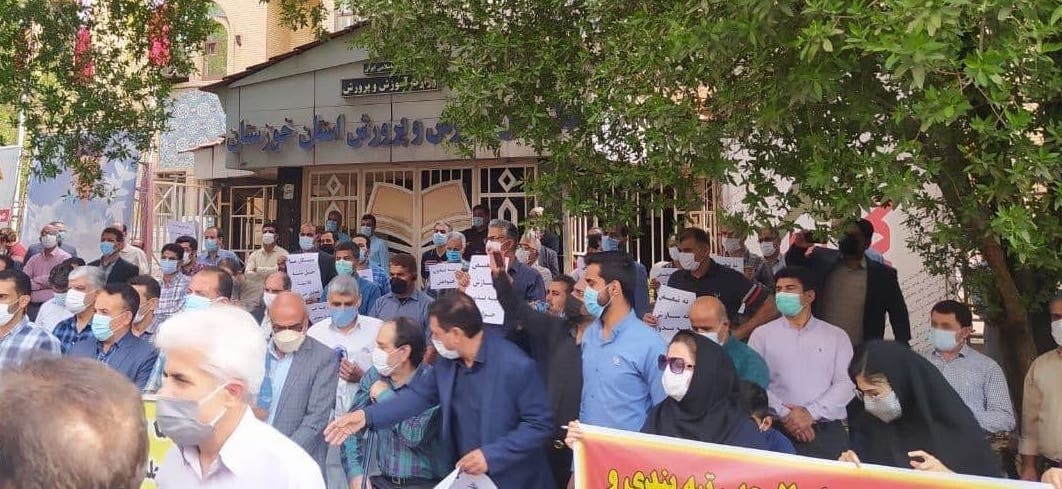 Teachers have been on strike in as many as 51 cities with slogans that included: “A livelihood is an unalienable right!” and “Free quality education for all!” / Image: Iranworkers, Twitter
Teachers have been on strike in as many as 51 cities with slogans that included: “A livelihood is an unalienable right!” and “Free quality education for all!” / Image: Iranworkers, Twitter
The regime exploits mass unemployment and the desperation in society in order to force teachers into low-paid, temporary contracts with salaries as low as 2.3 million toman. The teachers are not alone. Other public sector workers including nurses, doctors, university lecturers, bus drivers and others have engaged in constant protests over similar conditions. The Iranian capitalist class is driving public services to near-collapse through inflation, corruption and austerity, with one-third of the government’s budget being unfinanced. In the case of education, the crisis has been sharpened by distance learning since the pandemic and the ensuing social crisis unfolded, with many children having to drop out of school entirely to help support their families. This school term alone saw one million children drop out!
The coordinating council has stated that it considers “that the only way to fulfill our demands is the solidarity and unity of the workers in continuing the struggle”. The creation of the coordinating council involving rank-file teachers and the most radical trade unionists, including from regime-led trade unions, is an important step forward from the previous spontaneous protests. But the depths of the current crisis demands a united struggle of workers. The coordinating council must go further and call for the whole working class, and especially other public sector workers, to join the protests, bringing their own demands to the movement.
Revolution or barbarism
Capitalism is a waking nightmare for the overwhelming majority of Iranians. The US-led sanctions have brought the most despicable, parasitic characters from the Iranian capitalist class and placed them at the fore. Industry and infrastructure are collapsing with massive layoffs. Officially, inflation of food prices stands at 70%, and unemployment is at 25%. In reality they are much higher. Price controls and subsidies are meaningless in the face of such inflation, and only serve to breed a rampant black market led by the capitalists, while poor farmers are forced to choose between selling their produce at a loss or destroying it. Power shortages have become commonplace since the summer, despite Iran having the fourth largest energy reserves in the world!
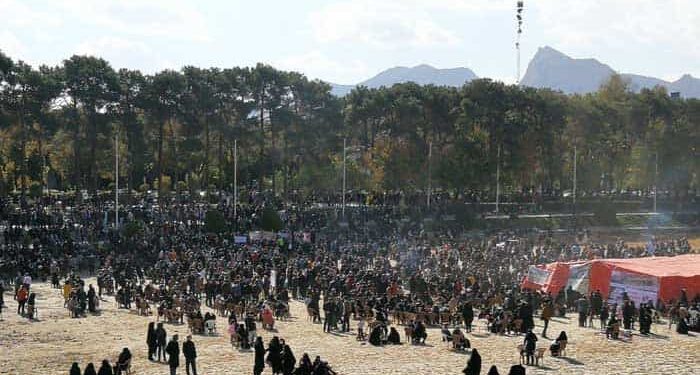 Price controls and subsidies are meaningless in the face of such inflation, and only serve to breed a rampant black market led by the capitalists, while poor farmers are forced to choose between selling their produce at a loss or destroying it / Image: Irankargar, TwitterAccording to the regime, two-thirds of the population are already living below the poverty line; double the figure from 2017, and there is no end in sight. The majority of Iranian workers are forced into temporary contracts, being paid the minimum wage at 4 million toman or less, a wage which is worthless in the face of inflation. Even the Islamic Labour Council admits that on minimum wage an average household is only capable of covering ten percent of its monthly expenses. The regime is fully aware of the threat that the class struggle presents but is completely incapable of offering a solution. With no other options they have no choice but to continue a ruinous policy of printing money to increase subsidies and welfare payments. All of this is exacerbated by the sanctions imposed by US imperialism. Of course, the regime is always more than willing to use this bogeyman of an external threat to push the masses into submission.
Price controls and subsidies are meaningless in the face of such inflation, and only serve to breed a rampant black market led by the capitalists, while poor farmers are forced to choose between selling their produce at a loss or destroying it / Image: Irankargar, TwitterAccording to the regime, two-thirds of the population are already living below the poverty line; double the figure from 2017, and there is no end in sight. The majority of Iranian workers are forced into temporary contracts, being paid the minimum wage at 4 million toman or less, a wage which is worthless in the face of inflation. Even the Islamic Labour Council admits that on minimum wage an average household is only capable of covering ten percent of its monthly expenses. The regime is fully aware of the threat that the class struggle presents but is completely incapable of offering a solution. With no other options they have no choice but to continue a ruinous policy of printing money to increase subsidies and welfare payments. All of this is exacerbated by the sanctions imposed by US imperialism. Of course, the regime is always more than willing to use this bogeyman of an external threat to push the masses into submission.
The new government, led by President Ibramrem Raisi, took leadership of the Islamic Republic in the midst of its deepest crisis since its inception 40 years ago. Already in the June sham presidential elections, the masses overwhelmingly rejected the regime with a massive boycott. The Raisi government’s attempts to placate the workers all but backfired. For instance, on 6 October, the president and ministers visited the oil workers of Assaluyeh but were met with a boycott by the workers’ strike organising council declaring: “we won’t go to ministers for talk and empty promises.” They explained further that “they (the politicians) only want to talk in front of 20 news cameras in order to exploit our struggle for their own gain”. On 9 November, the minister of labour, replying to a question from a journalist regarding the falling purchasing power of workers, answered by asking, “Why do you say workers? The purchasing power of employees, experts and senior managers has also decreased.” The usual appeal to national unity in the face of US imperialism’s sanctions has long ceased to have an effect. Even the Islamic labour organisation, the Workers’ House, criticised the minister for their lack of grasp of reality. All this shows how consciousness has developed through the class struggle since 2018. For a while now, the regime has been forced to rest to an increasing degree upon violence and suppression, or else the hope that strikes and protests will tire themselves out.
For a national labour movement! Campaign for a general strike!
Since 2018, the Islamic Republic has faced unprecedented waves of class struggle involving every layer of the working class with strikes, protests and even uprisings. Despite all this, the Islamic Republic remains in power. All uprisings, including the most recent July Khuzestan uprising, failed only on account of a lack of leadership. During the uprising, workers across the country spontaneously came out in solidarity and brought their own demands against the regime. If various workers’ campaigns and independent workers’ organisations had called for a general strike, the whole working class would’ve followed that call. In its absence, the Khuzestan uprising was isolated to the farmers and the youth in the cities, and as such it was swiftly defeated, with 505 arrested and 15 executed.
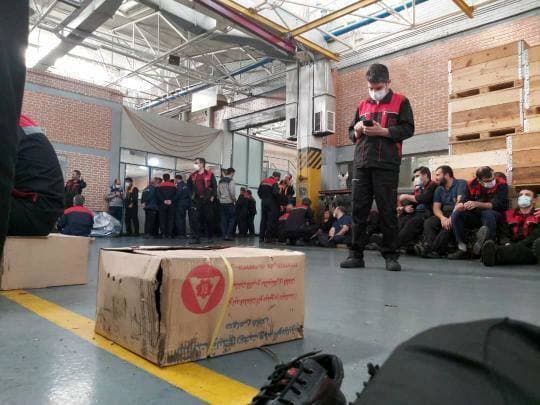 The current situation demands a united programme to weld together the scattered strikes and protests into one united force directed against the regime / Image: Iranworkers, Twitter
The current situation demands a united programme to weld together the scattered strikes and protests into one united force directed against the regime / Image: Iranworkers, Twitter
Already, the embryo of a movement of independent workers’ organisations has developed in the various national campaigns leading strikes and protests across the country. That the strike movement among the teachers, and oil and gas workers have lept from isolated local strikes to national campaigns with committees emerging at workplace and industry levels is a huge step forward. The manner in which radical demands are being picked up from one section of workers by another is a further symptom of how class consciousness is advancing. The emerging movement of the miners, who have taken their demand for nationalisation as well as militant methods of struggle directly from the example of the Haft Tappeh workers, is an excellent illustration of this process.
But while these campaigns and their demands are an important step forward, it is necessary to organise a united struggle of the whole working class and poor. The current situation demands more than declarations of solidarity between separate workers’ struggle. It demands a united programme to weld together the scattered strikes and protests into one united force directed against the regime.
The demands of such a programme would include the reversal of all austerity measures; living wages and pensions that increase with inflation; an extensive programme of public works to repair the country’s crumbling infrastructure; the renationalisation of all privatised companies under workers’ control; and the introduction of workers’ control throughout the state-owned economy. The following democratic demands must be included within such a programme too: the right to strike, protest and assemble; and an open call for the abolition of the Islamic Republic and the election of a constituent assembly.
Such a programme would find wide support across Iranian society. On the basis of such a programme, the independent workers’ organisations should prepare the conditions for a general strike as the first step towards the overthrow of the regime. Despite the repression that they have faced, the Iranian working class can and will build an independent labour movement as it has done so many times over. Once such a movement has developed, it will be capable of bringing an end to the hated Islamic Republic.

